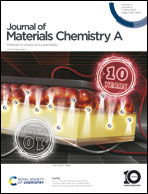Construction of a S and Fe co-regulated metal Ni electrocatalyst for efficient alkaline overall water splitting†
Abstract
Rational design of bifunctional transition metal electrocatalysts with customary efficiency for water splitting is essential for yielding high-purity hydrogen, but remains challenging. Herein, we propose a non-metal atom S and oxyphilic transition metal atom Fe co-regulation strategy to optimize the alkaline hydrogen evolution reaction (HER) and oxygen evolution reaction (OER) performance of metallic Ni (S–Fe–Ni). The S–Fe–Ni metal exhibits super activities with an ultralow overpotential of 25 mV and 200 mV at 10 mA cm−2 and 89 mV and 235 mV at 100 mA cm−2 for the HER and OER, respectively. When served as the cathode and anode, the S–Fe–Ni catalyst only needs 1.49 V to obtain 10 mA cm−2 for water splitting. Further experimental results and theoretical calculations reveal that the S and Fe induced electronic redistribution optimizes water and hydrogen adsorption for enhanced HER and the in situ derived S doped NiFe hydroxyl oxide is associated with the enhanced OER. This work puts forward new insights into designing transition metal bifunctional catalysts for alkaline water splitting.



 Please wait while we load your content...
Please wait while we load your content...